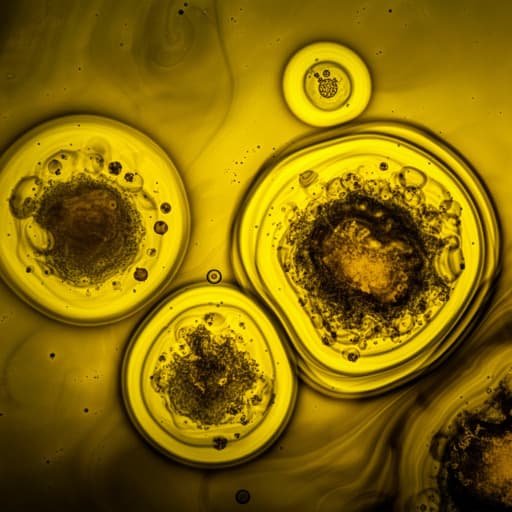
Food Science and Technology
Exploring the Connection between the Occurrence and Intensity of "Grubby" Defect and Volatile Composition of Olive Oil
K. B. Bubola, I. Lukić, et al.
Discover the intriguing relationship between the 'grubby' sensory defect in virgin olive oil and its volatile composition, as unveiled by researchers Karolina Brkić Bubola, Igor Lukić, Marin Krapac, and Olivera Koprivnjak. This study highlights how olive fruit fly infestation affects oil quality and sensory attributes, revealing key volatile compounds that contribute to the defect.
~3 min • Beginner • English
Introduction
Virgin olive oil quality assessment uniquely includes an official sensory (Panel test) evaluation focused on fruitiness and identification of dominant defects. While extensive research links sensory defects such as fusty/muddy sediment, musty/humid, winey-vinegary/acid-sour, rancid, and frostbitten olives to characteristic volatiles, less is known about secondary-list defects like "grubby" (flavour from olives heavily attacked by olive fruit fly grubs). Olive fruit fly infestation damages olive tissues, potentially altering oil quality and volatile profiles via mechanical disruption, microbial activity, and plant-insect interactions. Prior work noted changes in LOX-pathway volatiles and increases in fermentative markers, but "grubby" has been rarely and inconsistently reported. This study investigates the relationship between the intensity of the "grubby" defect and volatile composition in Leccino virgin olive oils produced from fruits with controlled infestation levels (0%, 50%, 100%), minimizing storage-related oxidative/fermentative confounders. Additional objectives were to evaluate effects on fatty acid composition and basic quality parameters of oils and pastes.
Literature Review
Previous studies reported that olive fly infestation can raise levels of certain LOX-pathway products (e.g., hexanal) and C6 alcohols, though effects on E-2-hexenal are inconsistent across studies. Microbial access following fruit damage can drive fermentative volatiles (ethanol, branched-chain alcohols, ethyl acetate) and has often been associated with fusty/musty/rancid defects rather than grubby. Some reports found no sensory defects even at 100% infestation, with only reduced positive attributes. Plant–insect interactions may also modulate volatile synthesis beyond mechanical damage, including emission of terpenes like β-ocimene and α-farnesene as defensive responses. Overall, the chemical basis of the "grubby" defect has not been clearly defined, and its linkage to specific volatile markers remains underexplored.
Methodology
- Sample preparation: Leccino olives (Istria, Croatia), ripening index 3.0, hand-harvested from the same tree, sorted into L-100% (at least one fly puncture or exit hole; approx. 80% exit holes/20% punctures), L-0% (healthy), and L-50% (1:1 mix of L-100% and L-0%). Each group processed in triplicate within 24 h using an Abencor system: hammer crushing, malaxation at 24 ± 1°C for 45 min, centrifugation at 3500 rpm for 60 s; oils decanted and stored in dark bottles at room temperature.
- Water and oil content in pastes: Water measured gravimetrically by drying at 80°C to constant weight; dried pastes stored at −18°C, reground and redried; theoretical oil content by Soxtec Avanti 2055 extraction.
- Oil quality parameters: Free fatty acids (FFA), peroxide value (PV), and UV spectrophotometric indices (K232, K268/K270, ΔK) by IOC methods per EU regulations.
- Fatty acid composition: FAMEs by GC-FID (Varian 3350; Rtx-2330 column). Identification via retention times vs. standards; results expressed as % of total FA area.
- Sensory analysis: IOC-approved VOO panel (n=8; 5 women, 3 men). Attributes rated on unstructured 0–10 scale; extended descriptors included olive fruitiness, other ripe fruits, apple, green grass/leaves, sweet; bitterness and pungency assessed; overall sensory quality scored 1–9.
- Volatile analysis: HS-SPME-GC/MS (Varian 3900 GC; Saturn 2100T MS). Identification via mass spectra vs. pure standards and NIST05; LRIs determined using C7–C24 alkanes; 20 volatiles confirmed by retention times; quantification using calibration in refined sunflower oil; semi-quantification for others assuming response factor of 1.
- Statistics: One-way ANOVA with Tukey HSD (p<0.05) for sensory and chemical data; Pearson correlations (r) among infestation level, defect intensities, and volatile concentrations; hierarchical cluster analysis (HCA) and partial least squares discriminant analysis (PLS-DA) using MetaboAnalyst 5.0.
Key Findings
- Oil paste composition and basic quality: Olive fly infestation did not significantly change water or oil content of pastes. At 100% infestation, FFA increased slightly (still within EVOO limits) and PV increased significantly (L-0% PV 7.55 mmol O2/kg; L-100% PV 10.76 mmol O2/kg), while UV indices remained within EVOO limits; all samples classified as EVOO.
- Fatty acids: No significant effects of infestation on fatty acid profile; oleic/linoleic ratio remained >11, supporting oxidative stability.
- Sensory: Positive attributes (olive fruitiness, apple, green leaf/grass) decreased with infestation, most in L-100%; "other ripe fruits" increased in L-50% and L-100%. Bitterness and pungency decreased, especially in L-100%. The predominant defect in infested oils was "grubby" (described as cocoa butter-like, fatty, sweet), more intense in L-100%; rancidity was low but detectable in L-100%. Overall sensory quality score decreased with infestation: 7.81±0.48 (L-0%), 7.09±0.74 (L-50%), 5.78±0.39 (L-100%).
- Volatiles and correlations: About 20 compounds showed very strong positive correlations with infestation and with "grubby" intensity. Notable markers included:
• Oxidative-related: 1-octanol (r with grubby = 0.9998), octanal (0.9965), 4-methyl-5H-furan-2-one (0.9944), hexanal (0.9922), 6-methyl-5-hepten-2-one (0.9904), E-2-nonen-1-ol, heptanal, E-2-heptenal, E,E-2,4-heptadienal, benzeneacetaldehyde.
• Fermentative-related: Ethyl 2-methylbutyrate (0.9992), propanoic acid (0.9491), dimethyl sulfoxide (0.9163), 2-methylbutanal (0.9156), 3-methylbutanal (0.9007), methyl acetate (weaker relation to grubby; stronger to rancid).
• Terpenes/other: β-ocimene (0.9924), α-farnesene (0.9973), phenylethyl alcohol.
- Concentration changes: Strong increases from L-0% to L-100% were observed for β-ocimene (~7×), α-farnesene (~10×), 4-methyl-5H-furan-2-one (~8×), 6-methyl-5-hepten-2-one (~3×), dimethyl sulfoxide (~5×), 2- and 3-methylbutanal (~3×). Propanoic acid increased in L-100%. Ethyl acetate showed no significant linear trend.
- LOX pathway: C6 aldehydes (except hexanal) did not correlate positively with infestation and showed minima at L-50%. E-2-hexenal/hexanal ratio decreased with infestation (157.9 → 58.3 → 99.8), indicating quality degradation.
- Multivariate analyses: HCA cleanly clustered oils by infestation level. PLS-DA separated L-0%, L-50%, L-100% groups; top VIPs included ethyl 2-methylbutyrate, 1-octanol, α-farnesene, 4-methyl-5H-furan-2-one, octanal, β-ocimene. In L-0% vs. L-100% PLS-DA, highest VIPs were 3-methylbutanal, 2-methylbutanal, β-ocimene, ethyl 2-methylbutyrate, dimethyl sulfoxide, 4-methyl-5H-furan-2-one, α-farnesene, 6-methyl-5-hepten-2-one, and several aldehydes.
- Negative correlations: Strong negative r values with grubby were found for branched-chain alkene II (−0.9973), 3-ethyl-1,5-octadiene I (−0.9899), pentanoic acid (−0.9895), 3-ethyl-1,5-octadiene II (−0.9833), and phenol (−0.9806).
Discussion
The study demonstrates that olive fruit fly infestation, under controlled conditions minimizing storage-related fermentation and oxidation, yields a distinct sensory profile dominated by the "grubby" defect. The defect’s intensity scales with infestation and aligns strongly with a suite of volatile compounds from oxidative degradation (e.g., medium-chain aldehydes/ketones and alcohols) and fermentative metabolism (e.g., branched aldehydes, ethyl 2-methylbutyrate, dimethyl sulfoxide), as well as terpenes (β-ocimene, α-farnesene) plausibly linked to plant defence responses. These findings suggest "grubby" is not driven by a single molecule but by the joint olfactory contribution of multiple volatiles reflective of both lipid oxidation and mild fermentative processes facilitated by tissue damage and microbial activity. The absence of prominent fusty/musty defects underscores the effect of prompt processing. LOX-derived volatiles showed irregular trends, but the decreasing E-2-hexenal/hexanal ratio and increases in oxidation-related volatiles are consistent with quality deterioration linked to infestation. Chemometric separations (HCA, PLS-DA) support the feasibility of instrumental screening to aid panel tests, with identified markers offering potential for confirming grubby presence and for quality classification.
Conclusion
Processing infested Leccino olives at early ripeness without storage produced oils where "grubby" was the main sensory defect, describable as cocoa butter-like, fatty, and sweet. The intensity of "grubby" increased with infestation and correlated strongly with concentrations of specific volatiles—particularly 3-methylbutanal, 2-methylbutanal, β-ocimene, ethyl 2-methylbutyrate, dimethyl sulfoxide, 4-methyl-5H-furan-2-one, α-farnesene, 6-methyl-5-hepten-2-one, 1-octanol, E-2-nonen-1-ol, benzeneacetaldehyde, heptanal, and octanal—indicating a combined origin from oxidative, fermentative, and defensive plant metabolisms. Basic chemical quality remained within EVOO limits, and fatty acid profiles were unaffected. The results identify promising volatile markers to instrumentally support sensory panels in confirming grubby and classifying oil quality. Future work should extend to other cultivars and conditions to build broader volatile-defect databases and validate marker robustness.
Limitations
- Single cultivar (Leccino) and one growing region; generalizability to other cultivars/regions may be limited. - Controlled processing without fruit storage and with early ripeness (RI 3.0) may not reflect typical industrial scenarios where storage can amplify fermentative defects. - Infestation composition skewed toward damaging (exit holes) vs. active (punctures); effects of different infestation types and severities were not independently isolated. - Small number of biological replicates (n=3 per group). - Volatile quantification relied partly on semi-quantitative estimates assuming response factor of 1 for compounds without standards.
Related Publications
Explore these studies to deepen your understanding of the subject.







